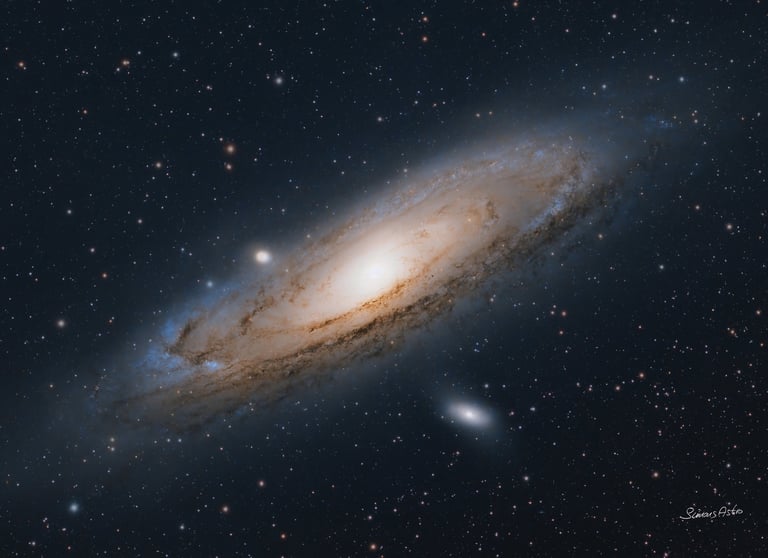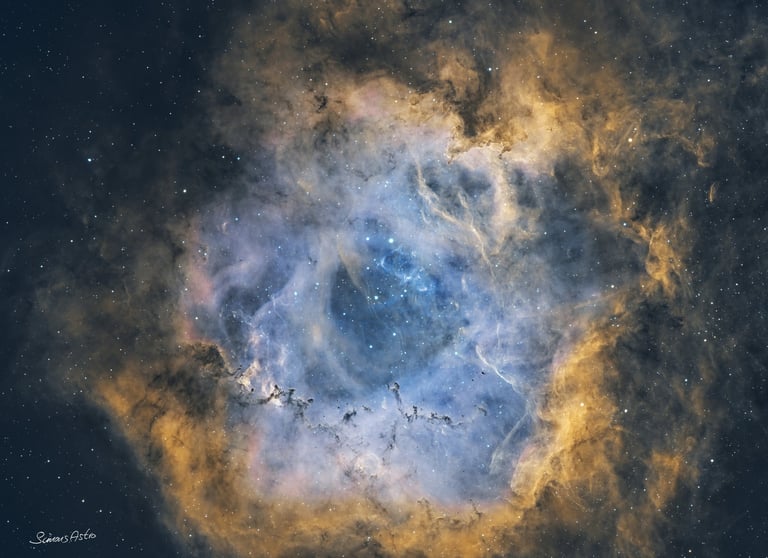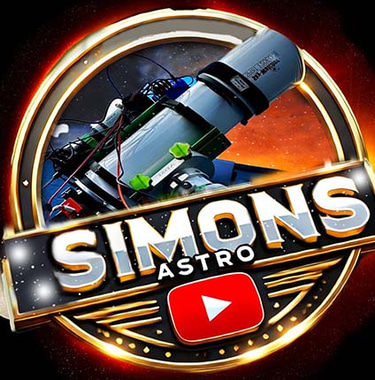Deep Space Astro Images
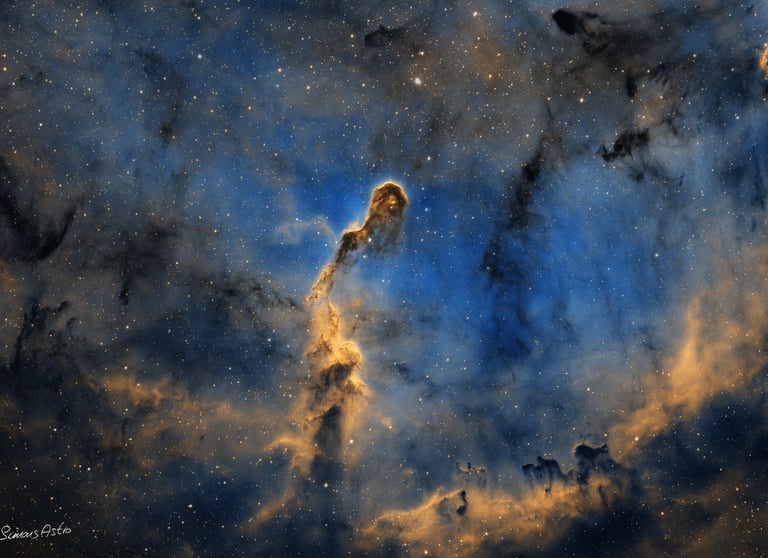

The Elephants Trunk Nebula
The Elephant's Trunk Nebula, officially known as IC 1396A, (2400 light years away) is a stunning region of star formation located in the constellation Cepheus. This nebula gets its name from its distinct shape, which resembles the trunk of an elephant stretching through space. Composed of gas and dust, the Elephant's Trunk serves as a stellar nursery, where new stars are born from the dense material within. The area is part of a larger complex known as the IC 1396 nebula, which contains a rich tapestry of vibrant colors and intricate structures formed by nearby stars and the obscuring dust. This image was captured with my Esprit 120, reduced to 648mm on the 2600 mono camera, a total of 5hrs:30mins with SHO 3nm Antlia filters.
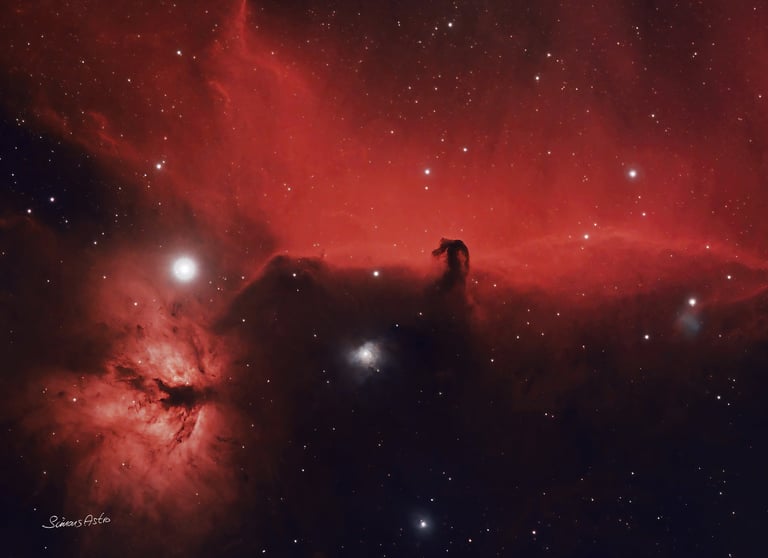

The Horsehead Nebula
The Horsehead Nebula, located in the constellation Orion, is one of the most iconic nebulae in the night sky. This dark molecular cloud stretches approximately 3.5 light-years tall and is best known for its striking horsehead shape, which can be seen against the backdrop of glowing hydrogen gas in the surrounding region. The nebula is a stellar nursery, where new stars are born amidst the dense gas and dust. Although it appears dark in visible light, the Horsehead is illuminated in infrared, revealing the intricate structures within. Its distance from Earth is approximately 1,500 light-years away. This was taken with my ZWO 2600 One Shot Colour camera and Optolong LExtreme filter, a total of 2hrs data.
The Rossette Nebula
The Rosette Nebula, also known as NGC 2237, is a stunning large emission nebula located in the constellation Monoceros, approximately 4,500 light-years away from Earth. Its name derives from its resemblance to a blooming rose, as the nebula is a crescent-shaped region of bright gas and dust surrounded by a star cluster known as NGC 2244. The Rosette Nebula is a stellar nursery, where new stars are formed from the clouds of hydrogen and other gases. The nebula spans roughly 50 light-years in diameter. This was taken with my ZWO 2600mm camera and Esprit 120 reduced to 648mm at F5.6. A total of 29.5 hrs of Sii, Ha and Oiii data, 3nm Antlia filters.
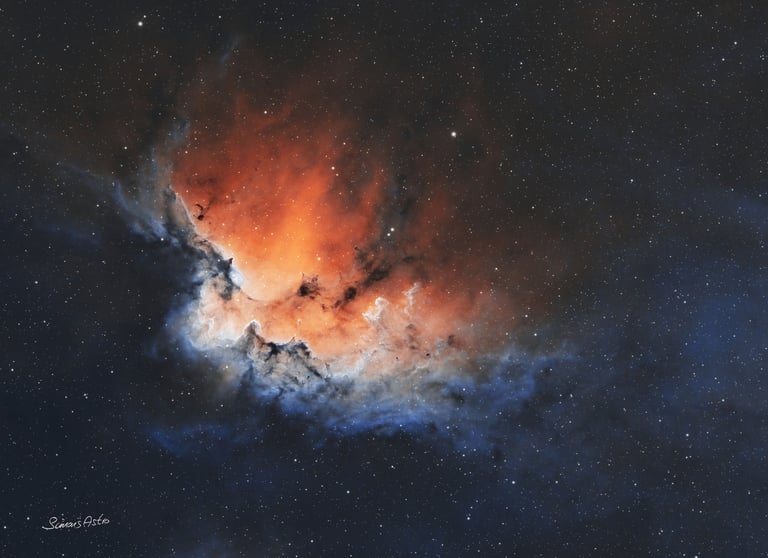

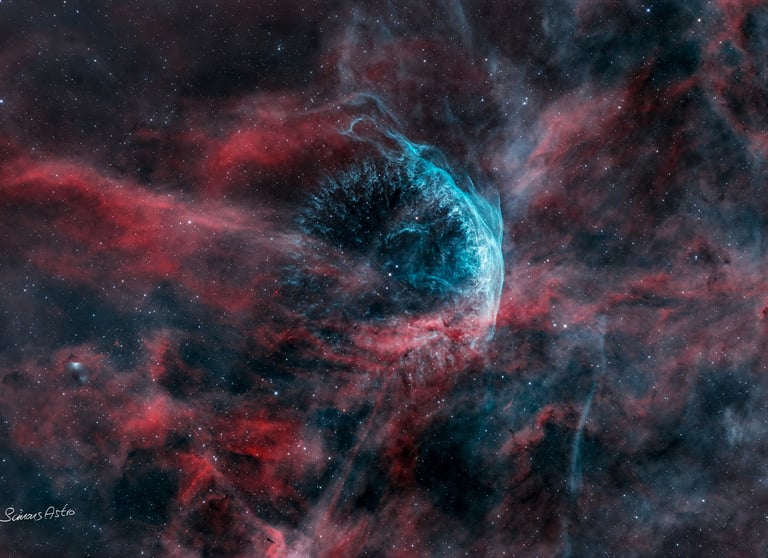

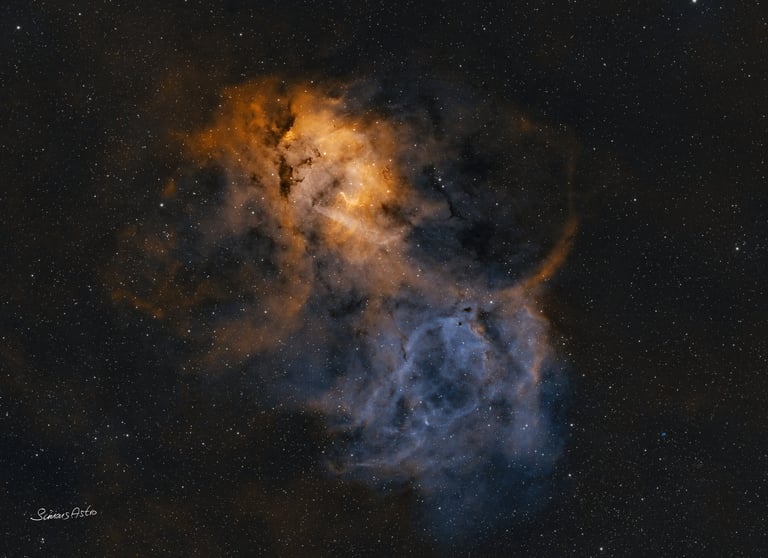

The Wizard Nebula
The Wizard Nebula, also known as NGC 7380, is an enchanting open cluster and emission nebula located in the constellation Cepheus. Discovered by the astronomer Carolyn Herschel in 1787, this stunning cosmic formation lies approximately 7,200 light-years away from Earth. The nebula is notable for its ethereal, wispy appearance, resembling a wizard conjuring magic, which gives it its name. NGC 7380 is home to a young group of stars, which play a crucial role in the surrounding gas and dust. This was taken with my ZWO 2600 mono camera and the Skywatcher Esprit 120 at 840mm. A total of 10hrs of SHO data with the 3nm Antlia filters.
WR 134
WR 134, a mesmerizing Wolf-Rayet star, captivates astronomers and stargazers alike with its extraordinary characteristics. Located approximately 5,000 light-years away in the constellation of Cygnus, this star showcases the dramatic life stages of massive stars, shedding its outer layers and revealing a blazing core. The image of WR 134 reveals intricate structures formed by powerful stellar winds. This image was a collaboration with Glenn from Astrobloke. We both used Our ZWO 2600mm cameras and together we captured over 51 hrs of HOO data (Hydrogen and Oxygen) Esprit 120 at 840mm and 3nm Antlia filters.
The Lion Nebula
The Lion Nebula, also known as SH2-132, is a faint emmisions nebula located in the constellation of Cepheus. This massive region of star formation, showcases intricate structures of gas and dust illuminated by the energy of newborn stars. It is part of a molecular cloud complex situated relatively close to the Milky Way, approximately 800 light-years from Earth. This nebula is renowned for its striking features, including the intricate patterns of gas and dust that give it a distinct appearance, resembling the mane of a lion. I took this image with my 2600 ZWO One Shot Colour camera and the Askar FRA 400, a total of 15hrs of data.
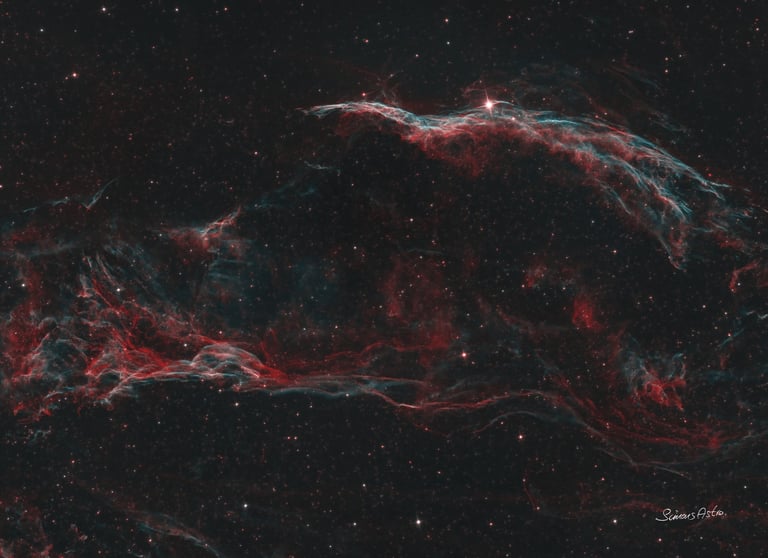

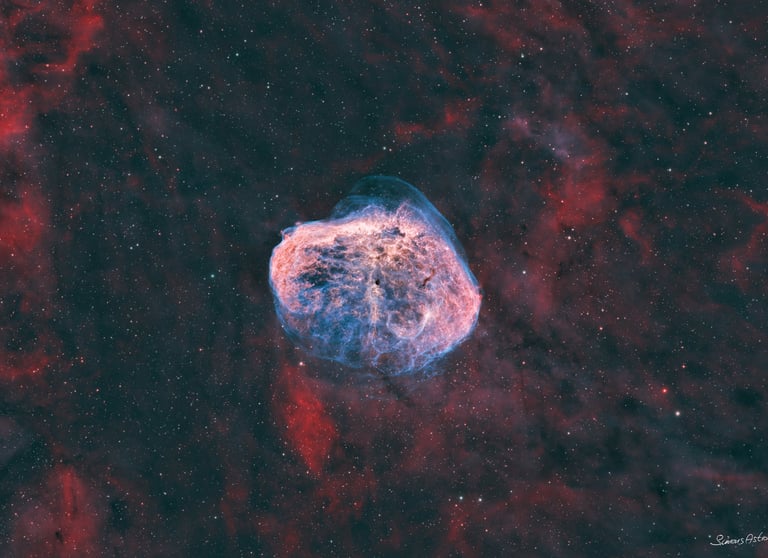

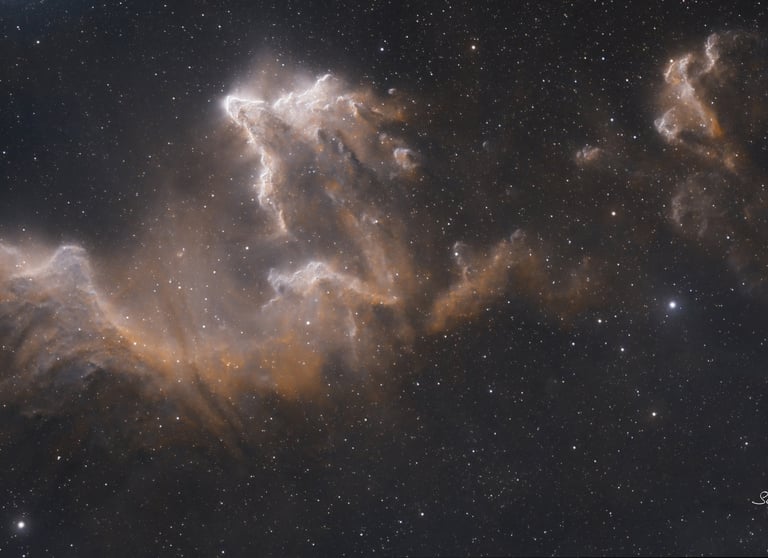

The Witches Broom
The West Veil Witches Broom Nebula, also known as NGC6960, is a stunning and ethereal astronomical phenomenon located in the constellation Cygnus, approx 2400 light years away. This diffuse emission nebula is the remnant of a supernova explosion, which has given rise to its unique, intricate shapes that resemble a delicate broom sweeping through the cosmos and is part of the larger Cygnus loop. This image was a collaboration with Glenn from Astrobloke. We both used Our ZWO 2600mm cameras and together we captured over 7.5 hrs of LRGB Ha & Oiii data.
The Crescent Nebula
The Crescent Nebula, also known as NGC 6888, is a stunning emission nebula located in the constellation Cygnus. This celestial object is formed from the stellar winds and gases expelled by a dying star, specifically a Wolf-Rayet star. The nebula's unique shape resembles a crescent, which is a result of shock waves interacting with the surrounding interstellar medium. The bright, intricate structures of the nebula are composed of ionized gases, predominantly hydrogen and helium, which emit a dazzling array of colors when illuminated by the intense radiation from the central star. 52 Hrs total with ZWO 2600mm Pro camera and the Skywatcher Esprit 120 at 840mm.
The Ghost of Cassiopeia
IC 63, commonly known as the Ghost of Cassiopeia, is a fascinating reflection nebula located in the constellation Cassiopeia. This ethereal cloud of gas and dust interacts with the intense radiation emitted from the nearby star, Gamma Cassiopeiae, creating a stunning visual contrast in the night sky. IC 63 plays a vital role in the study of star formation, as it contains various regions where new stars are beginning to emerge. Its proximity to the Cassiopeia constellation, coupled with its ghostly allure, makes IC 63 a compelling object of interest for astrophotographers at 550 light years away. This image was captured with my mono 2600 camera and 3nm Antlia filters, a total of 25hrs SHO data.
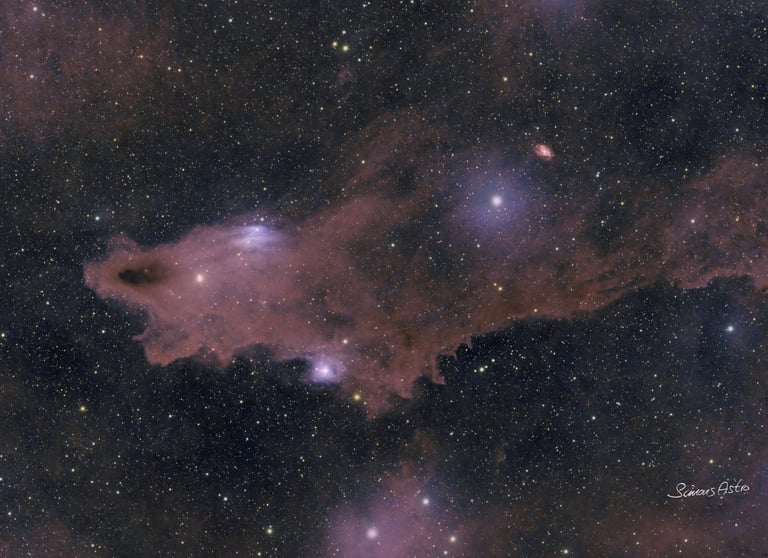

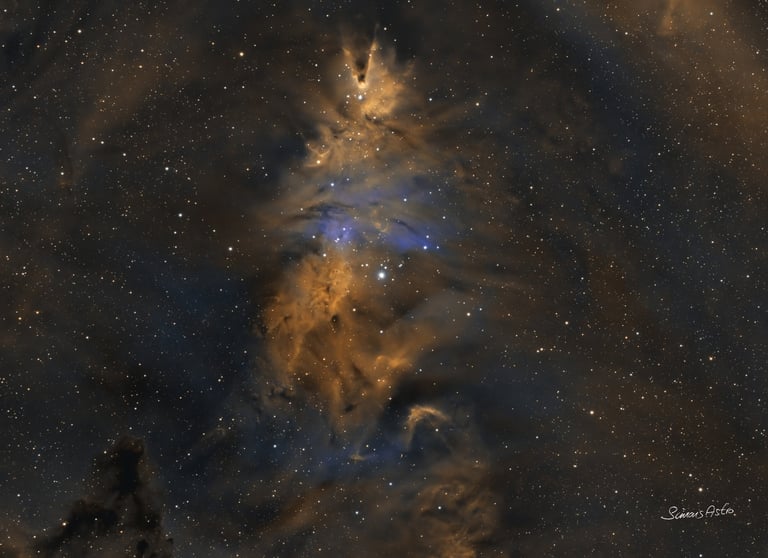

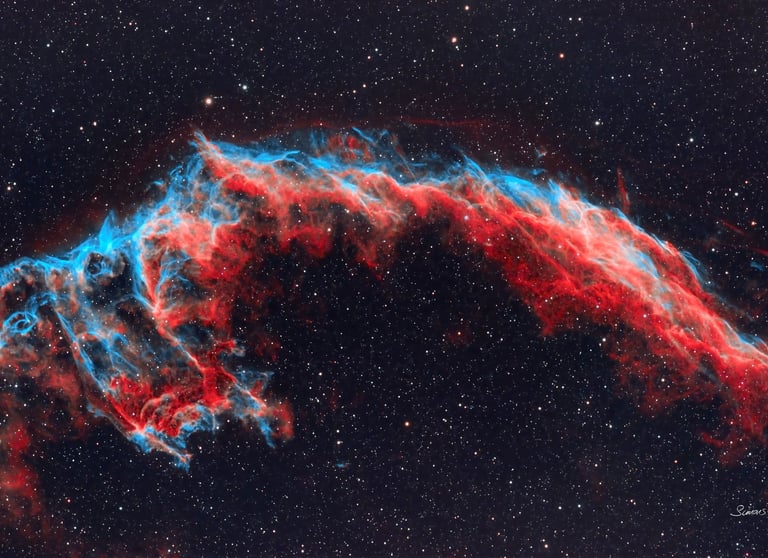

The Christmass Tree Nebula
The Christmas Tree Nebula, also known as NGC 2264, is a fascinating region located in the constellation Monoceros, the Unicorn. This striking nebula gets its name from its unique shape, which resembles a decorated Christmas tree against the vast backdrop of space. Illuminated by bright stars, including the prominent S Monocerotis, the nebula serves as a stellar nursery where new stars are being born. The intricate structures within the nebula are primarily composed of gas and dust, providing the necessary material for star formation. A total of just 2hrs and 40 mins exposure of SHO data shot with the Esprit 120 and ZWO 2600 mono.
The Dark Shark Nebula
The Dark Shark Nebula, also known as LDN 1235, is a striking feature in the cosmos, is a fascinating region shrouded in mystery and intrigue. Located in the constellation of Cepheus, this dark nebula appears as a vast, opaque cloud that stands in stark contrast to the luminous stars surrounding it. Composed primarily of dust and gas, the Dark Shark Nebula serves as a cosmic incubator for new stars, cloaked within its dense materials. As light from distant stars is absorbed and scattered, the nebula's distinct shape, reminiscent of a shark gliding through the void, captivates both amateur and professional astronomers alike. Shot with the Askar FRA 400 and 2600 One Shot Colour, 8hrs.
The East Veil Nebula
The East Veil Bat Nebula, (NGC 6992) part of the larger Veil Nebula complex, is a stunning remnant of a supernova explosion that occurred around 5,000 to 8,000 years ago. This celestial structure is located in the constellation Cygnus and showcases intricate filaments of gas and dust that shimmer with the light of distant stars. The nebula's delicate filaments are primarily composed of ionized hydrogen, contributing to its ethereal appearance. Photographers and astronomers often target this region for its striking visuals, especially in color-enhanced images that reveal a spectrum of hues, including blues, reds, and greens.
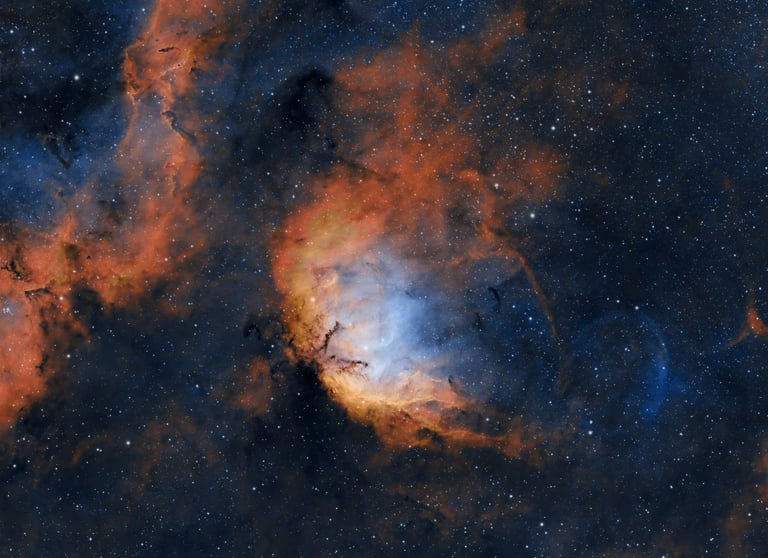

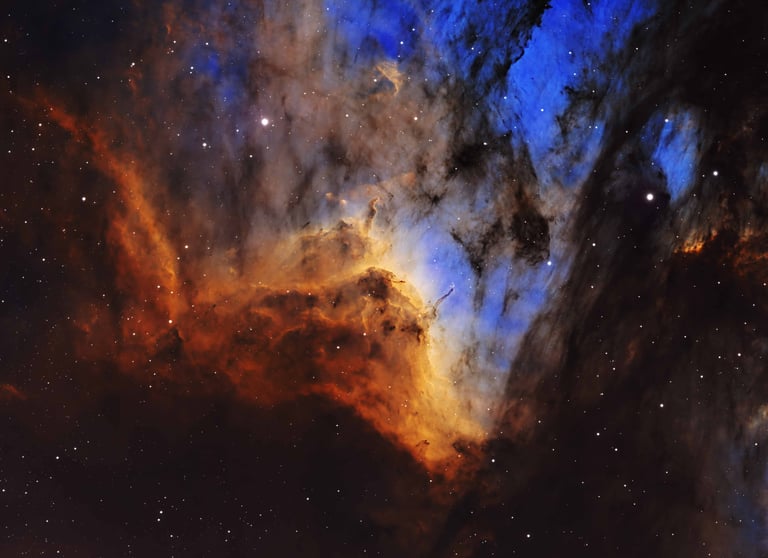

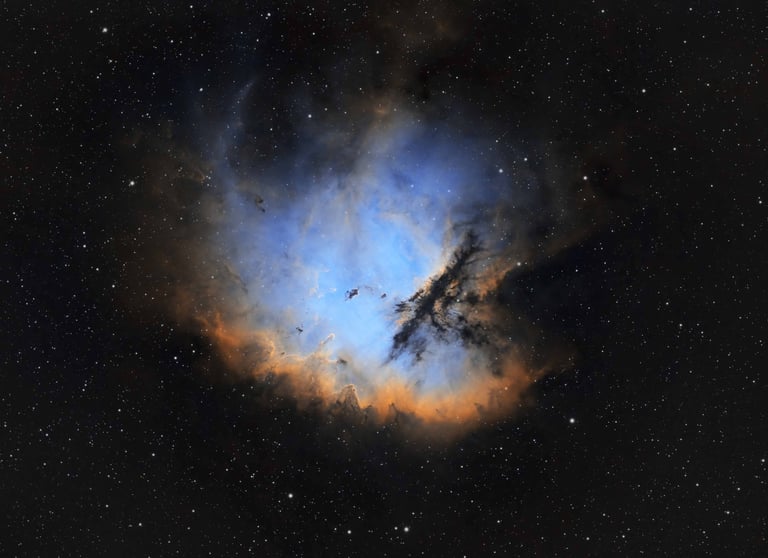

The Tulip Nebula
The Tulip Nebula, designated as Sh2-101, is a magnificent celestial object located approximately 5,000 light years away from Earth. This stunning nebula is situated in the constellation Cygnus and is part of a larger region of star formation. Its intricate patterns and vibrant colors are a result of energetic processes occurring within the nebula, where young stars are born and emit intense radiation. Observations of Sh2-101 reveal a delicate structure resembling a blooming tulip, hence its name. This was imaged with my Esprit 120 and the ZWO 2600 mono camera with a total of 15 hrs of SHO data at 840mm.
The Pelican Nebula
The Pelican Nebula, located approximately 1,800 light-years away from Earth, is an intriguing region of star formation that captivates astronomers and stargazers alike. This stunning nebula, part of the larger IC 5070 complex, is notable for its distinctive shape that resembles a pelican in flight, hence its name. Composed primarily of hydrogen gas and dust, the Pelican Nebula serves as a cosmic nursery, where new stars are born amid swirling clouds of interstellar material. This image is only 2hrs and 40 mins of Sii, Ha and Oiii data shot with the 2600mm camera and Esprit 120 telescope.
The Pacman Nebula
The Pacman Nebula, also known as NGC 281, is located approximately 8,000 light-years away from Earth and is a mesmerizing region of star formation in the constellation Cassiopeia. Known for its distinct resemblance to the classic arcade character Pacman, this vibrant nebula is an intricate tapestry of gas and dust. The nebula emits a captivating glow, fueled by the energetic processes of newly formed stars. I shot this image with the Starwave Acent 130 APO on loan from Altair Astro. Its a total of 3hrs of SHO data shot with the ZWO 2600mm pro camera and the 3nm Antlia filters.
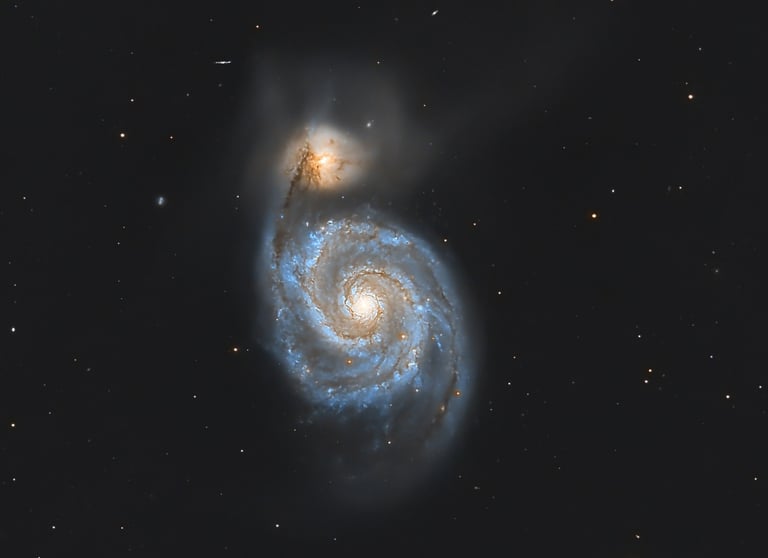

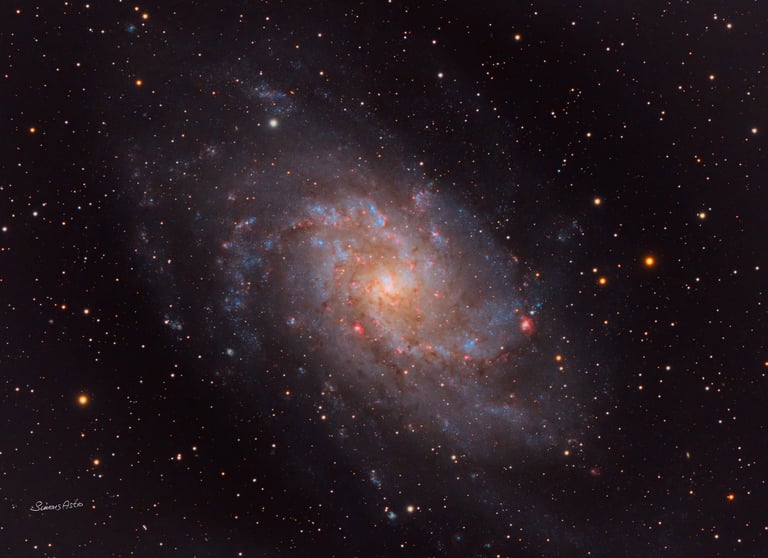

The Andromeda Galaxy
The Andromeda Galaxy, located approximately 2.5 million light-years from Earth, is the closest spiral galaxy to our own Milky Way. It is a magnificent celestial structure, harboring an estimated one trillion stars, making it one of the largest galaxies in our local group. Its majestic spiral arms are filled with young, hot stars and clouds of gas, creating a beautiful contrast against the dark cosmic backdrop. As Andromeda and the Milky Way are on a collision course, astronomers study this galaxy to understand the evolution of galaxies and the dynamics of cosmic interactions. I shot this with my Askar FRA400 and one shot colour camera, a total of on 1 hr integration.
The Whirlpool Galaxy
The Whirlpool Galaxy, also known as M51, is an extraordinary spiral galaxy located approximately 23 million light-years away from Earth. Discovered in 1773, it has captivated astronomers and stargazers alike with its stunning appearance and dynamic structure. This galaxy features a well-defined spiral shape, characterized by bright, sweeping arms filled with stars, gas, and dust, creating a beautiful contrast against the dark void of space. Its interaction with the nearby dwarf galaxy, NGC 5195, adds to the fascinating dynamics of the system, resulting in a cosmic dance that influences star formation. This was imaged with my Esprit 120ED and 2600 mono camera, a total of 13.6 hours integration time.
The Triangulam Galaxy
The Triangulum Galaxy, also known as M33, is a stunning spiral galaxy located approximately three million light-years away from Earth, making it one of our closest galactic neighbors. With its diameter of about 60,000 light-years, it is the third-largest member of the Local Group, which also includes the Milky Way and the Andromeda Galaxy. The Triangulum Galaxy is particularly notable for its well-defined structure, featuring numerous star clusters and nebulae, which contribute to its vibrant appearance. This is a total of 4hrs integration time using my ZWO 2600 mc pro one shot colour camera and the Esprit 120ED telescope at 840mm F7
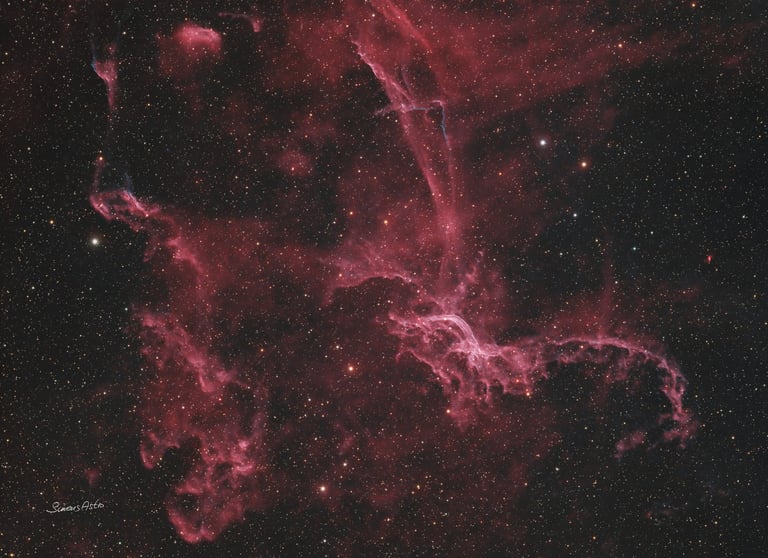

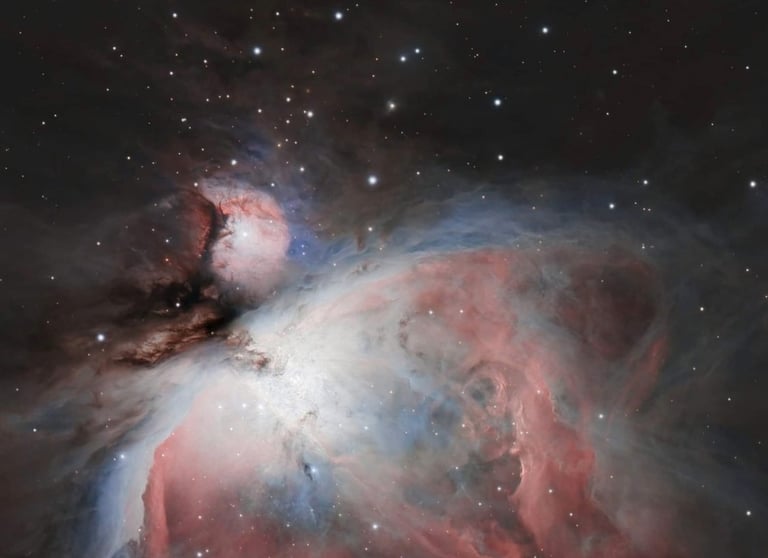

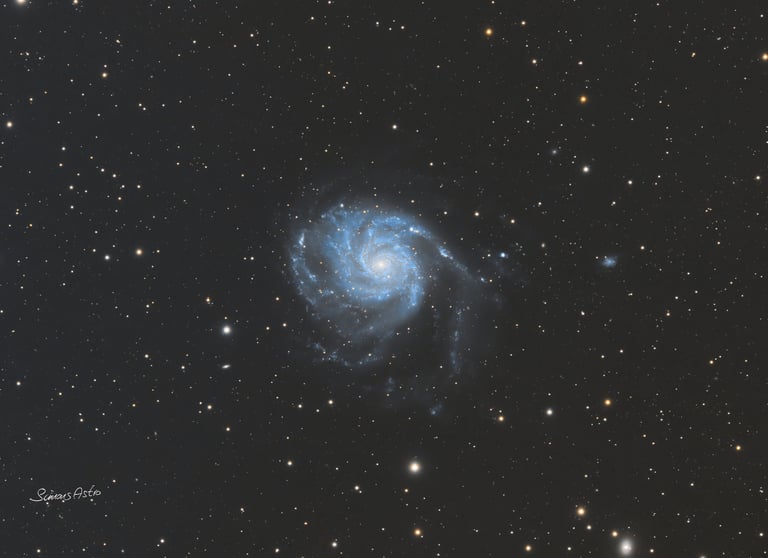

The Pinwheel Galaxy
The Pinwheel Galaxy, also known as M101, is an exquisite spiral galaxy located approximately 21 million light-years away from Earth. This stunning celestial body is renowned for its well-defined spiral arms, which are rich in star formation and vibrant clusters of young stars. The galaxy spans about 170,000 light-years in diameter, making it larger than our Milky Way. Its bright core is surrounded by a halo of gas and dust, contributing to its spectacular appearance in the night sky. The Pinwheel Galaxy offers astronomers a valuable opportunity to study the processes of galaxy formation and evolution. The was shot with my 2600 mono camera just 7.5hrs using the LRGB 3nm Antlia filters.
The Flying Dragon
The Flying Dragon Nebula, (SH2-114) located approx 12400 light-years away in the constellation Cygnus, captivates astronomers and stargazers alike with its breathtaking beauty and astronomical significance. This mesmerizing nebula takes its name from its distinct shape, resembling a mythical dragon soaring through the cosmos. It is a nursery for new stars, with dense pockets of gas and dust swirling together to ignite stellar birth. The Flying Dragon Nebula is a vital point of interest in both popular astronomy and scientific research. Its allure lies not just in its appearance but in the mysteries it holds within the vast expanse of space. This was a total 12 hrs data taken with the mono 2600 camera and 3nm filters.
The Great Orion Nebula
The Great Orion Nebula, (and Running Man) a stunning celestial masterpiece, is located approximately 1,344 light-years away from Earth. This vibrant region of star formation is nestled within the Orion constellation and serves as a stellar nursery, where new stars are born from the dense clouds of gas and dust. With its mesmerizing colors and intricate structures, the nebula captivates astronomers and stargazers alike. Observing the Orion Nebula through powerful telescopes reveals a dynamic and evolving environment, teeming with the potential for future star systems. Shot with my ZWO 2600mc pro one shot colour camera, and the Esprit 120ED at 840mm. I used the Optolong L Pro filter and imaged a total of 2hrs & 8 mins, using short exposures of 20 secs.
